
PHRC015 : Dedication of a nymphaeum to Ptolemy IV and Arsinoe III, Itanos - Crete (220-209 BC) Dedication
Permanent ID http://s.phrc.it/phrc015
Images:
Photo 1: the stone; Herakleion Museum, Inv. No. 64, copyrighted image. Courtesy of the Greek Ministry of Culture and Sports, Department of Antiquities
Photo 2: view of the southern bay of Itanos (Ptolemaic harbour) from the estern acropolis (S. Caneva, CC-BY-SA 4.0)





